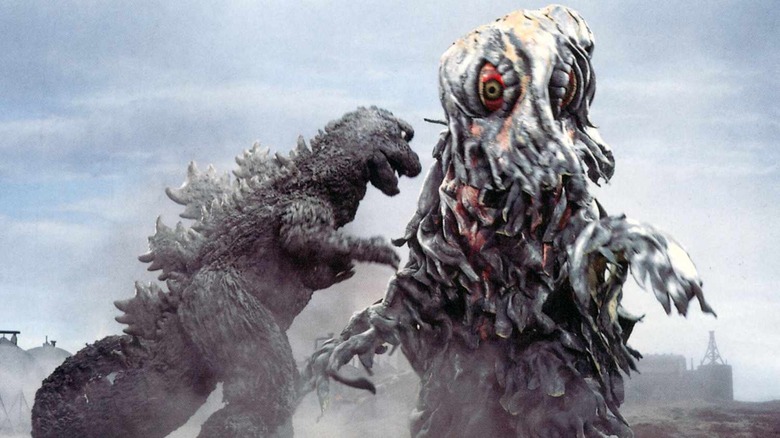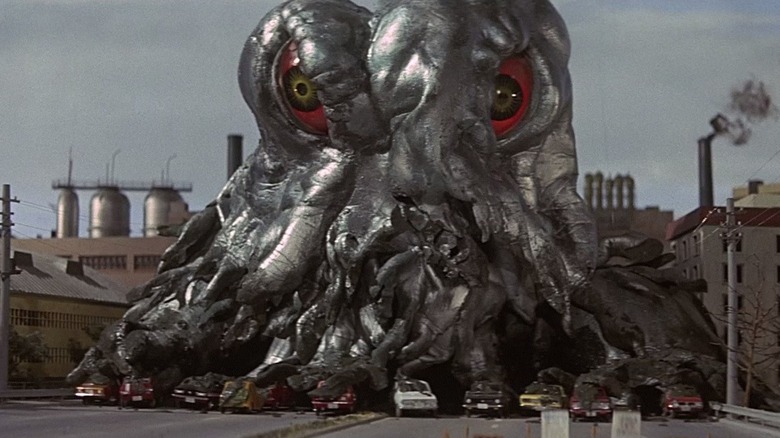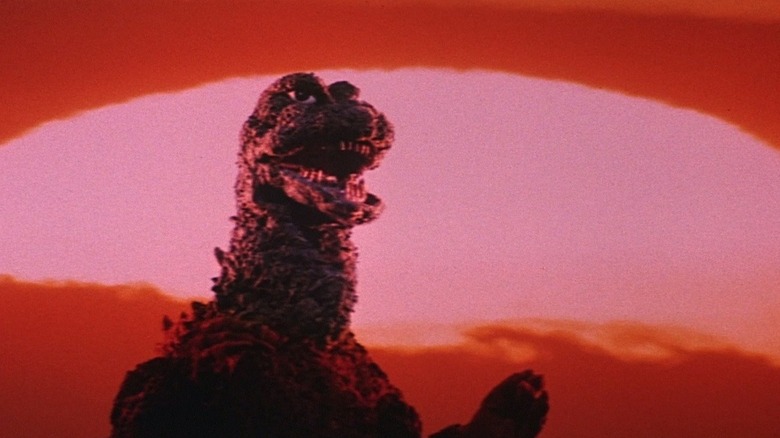Godzilla Fought Pollution In The Most Bonkers Monster Movie Of The '70s
Yoshimitsu Banno's 1971 kaiju flick "Godzilla vs. Hedorah" is an outlier in the larger "Godzilla" movie canon for several reasons. For one, it's the only one Banno wrote and directed, and he created his own tone, pace, and style, which were very different from other "Godzilla" directors. From 1954 through 1975, only Ishiro Honda or Jun Fukuda directed "Godzilla" movies ("Godzilla Raids Again" notwithstanding), so Banno was like a renegade scientist breaking into a lab and seeing what he could concoct using other filmmakers' chemicals.
And the premise is very, very weird. And that's saying something, considering the "Godzilla" films had already introduced a baby Godzilla into the mix. In "Godzilla vs. Hedorah," Godzilla fights a slimy glop monster born of human pollution. It's the only time the radioactive Godzilla has become an environmentalist. "Godzilla vs. Hedorah" was released as "Godzilla vs. the Smog Monster" in the United States, which sounds like something from an episode of "Captain Planet and the Planeteers." It just happened to beat Captain Planet to the punch by 19 years.
The origins of Hedorah are explained right at the start of the film. An alien space probe carrying a slime creature crashes on Earth. The creature seeps into the oceans and begins slowly sucking up filth and pollution. It grows larger and larger, eventually crawling out of the water to inhale smoke from a factory smokestack. Eventually, the slime monster grows large enough and absorbs enough smog energy to fly around and walk upright. Godzilla is nearby (natch) and is quick to rip Hedorah to shreds. However, because Hedorah is made of muck, he can easily reconstitute and return multiple times. Godzilla, the world's preeminent monster pugilist, is faced with his toughest fight yet in "Godzilla vs. Hedorah." He's essentially fighting the concept of pollution.
Godzilla vs. Hedorah's tone is all over the place
It should be noted that "Godzilla vs. Hedorah" came when the "Godzilla" franchise appeared to be losing steam, giving way to increased silliness and outlandish monsters. The budget on "Godzilla vs. Hedorah," therefore, was much lower than on previous "Godzilla" movies, and it was filmed in just 35 days. It was also Banno's directorial debut, and he often butted heads with some of the old-guard "Godzilla" makers. "Godzilla vs. Hedorah," for instance, was meant to be a downbeat and serious film about the dangers of pollution, perhaps similar in tone to Honda's 1954 original "Godzilla." However, the movie series was just coming off of Honda's 1969 film "All Monsters Attack," which was about a little kid and his dream-world kinship with Godzilla's chibi son Minya. The films were skewing more kid-friendly, and Banno wanted to keep the tone light and appropriate for kiddie matinées.
The original script (credited to Banno and Kaoru Mabuchi), despite Banno's need to make something kid-friendly, was weirdly dark and featured a lot of human deaths. Producer Tomiyuki Tanaka added a few extra comedy scenes to keep the movie light.
As a result, the tone of "Godzilla vs. Hedorah" is all over the place. It's absurd, violent, bleak, ridiculous, funny, whimsical, and plays like a Saturday morning cartoon. This is the film where Godzilla tucks his tail up under his legs, whirls around, and flies through the air, back-first, using his atomic breath as a means of locomotion. It's a pretty silly sight. But there's also an air of hopelessness to the movie that stands counter to its whimsy. When Hedorah begins killing people by the thousands, humanity decides to throw a huge bash, knowing it'll be dead any moment. The film is downright apocalyptic.
The end of Godzilla vs. Hedorah is very strange
Despite this, the film's score (by Riichiro Manabe) indicates that all of this is in good fun. The music is all marches and whimsical trumpets. There is a song at the end of the film, after Hedorah has been defeated, about how there are no people left on Earth to mourn. The melody, however, is upbeat. Also, there are people left. The end caption on the screen is a grave warning of "Will there be another?" It's asking the audience if we'll stop polluting or risk another Hedorah showing up. It should also be noted that "Godzilla vs. Hedorah" features some brief animated portions, making the environmental message explicit. It's like a cross between a "Sesame Street" segment and the Necronomicon.
The final fight in "Godzilla vs. Hedorah" is a grueling two-pronged attack. Humanity realizes it has to dry Hedorah's oily, sewage-filled body out, so the Japanese military constructs a drying-out ray. (When characters talk about drying out a living mound of sewage, try not to think of a cow patty.) Eventually, Hedorah is dried out enough for Godzilla to step in, pull out Hedorah's eyeballs, and blast them with his radioactive breath. This monster requires more special attention than other Godzilla foes, which can usually be simply throttled.
While "Godzilla vs. Hedorah" made some money, it didn't really move the needle on Godzilla's waning popularity. Its producers hated the film so much that Banno was fired from the franchise and his planned sequel, "Godzilla vs. Redmoon," never came to pass.
These days, Godzilla fans love "Hedorah" for its weirdness. It's a very different animal than its contemporaries, and many odd cineastes appreciate it on that level. In short, see it right away.


